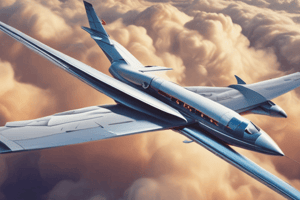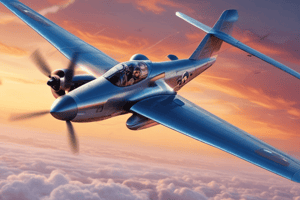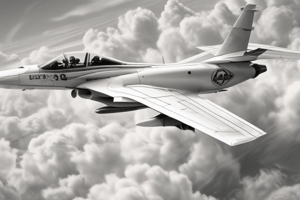Podcast
Questions and Answers
What is the primary factor that contributes to the occurrence of an aircraft stall?
What is the primary factor that contributes to the occurrence of an aircraft stall?
- Exceeding the critical angle of attack (correct)
- Load factors affecting aircraft maneuverability
- Propeller performance under different conditions
- Air density at varying altitudes
What is the primary goal of engineers when designing propellers?
What is the primary goal of engineers when designing propellers?
- To optimize propeller performance under different flight conditions (correct)
- To increase aircraft weight and balance
- To reduce the angle of attack of the propeller blades
- To minimize energy loss due to drag and slipstream effects
What is the result of exceeding the critical angle of attack during flight?
What is the result of exceeding the critical angle of attack during flight?
- A sudden increase in lift
- A sudden decrease in lift (correct)
- An increase in aircraft maneuverability
- A decrease in propeller performance
What is affected by changes in air density at varying altitudes?
What is affected by changes in air density at varying altitudes?
What is the primary concern for pilots when responding to an aircraft stall?
What is the primary concern for pilots when responding to an aircraft stall?
What is the relationship between load factors and aircraft maneuverability?
What is the relationship between load factors and aircraft maneuverability?
What is the primary consideration for pilots when operating under different flight conditions?
What is the primary consideration for pilots when operating under different flight conditions?
What is the result of not responding appropriately to an aircraft stall?
What is the result of not responding appropriately to an aircraft stall?
What is the primary concern for engineers when designing aircraft propellers?
What is the primary concern for engineers when designing aircraft propellers?
What is the relationship between aircraft weight and balance and aircraft stalls?
What is the relationship between aircraft weight and balance and aircraft stalls?
Aircraft stalls can be avoided by reducing the power output during flight.
Aircraft stalls can be avoided by reducing the power output during flight.
The critical angle of attack is the only factor that contributes to an aircraft stall.
The critical angle of attack is the only factor that contributes to an aircraft stall.
Propeller performance is not affected by air density changes at varying altitudes.
Propeller performance is not affected by air density changes at varying altitudes.
Load factors have no impact on aircraft safety.
Load factors have no impact on aircraft safety.
Pilots can recognize the onset of a stall by monitoring the aircraft's airspeed only.
Pilots can recognize the onset of a stall by monitoring the aircraft's airspeed only.
Aircraft stalls can occur only during takeoff and landing.
Aircraft stalls can occur only during takeoff and landing.
The design of propellers is not critical to optimizing efficiency in aircraft operation.
The design of propellers is not critical to optimizing efficiency in aircraft operation.
The angle of attack of the propeller blades has no effect on propeller efficiency.
The angle of attack of the propeller blades has no effect on propeller efficiency.
Pilots can respond to an aircraft stall by increasing the angle of attack.
Pilots can respond to an aircraft stall by increasing the angle of attack.
Theoretical understanding of aerodynamics is sufficient for real-world flight operations.
Theoretical understanding of aerodynamics is sufficient for real-world flight operations.
What critical skills must pilots possess to effectively respond to an aircraft stall, and what specific actions should they take to regain lift?
What critical skills must pilots possess to effectively respond to an aircraft stall, and what specific actions should they take to regain lift?
How do changes in air density at varying altitudes affect propeller efficiency, and what design considerations can optimize thrust?
How do changes in air density at varying altitudes affect propeller efficiency, and what design considerations can optimize thrust?
What role do load factors play in ensuring aircraft safety, and how do they impact maneuverability?
What role do load factors play in ensuring aircraft safety, and how do they impact maneuverability?
How do aircraft weight and balance impact stall behavior, and what considerations should pilots take when flying with varying load configurations?
How do aircraft weight and balance impact stall behavior, and what considerations should pilots take when flying with varying load configurations?
What is the relationship between propeller performance and aircraft safety, and how do design considerations impact overall flight operations?
What is the relationship between propeller performance and aircraft safety, and how do design considerations impact overall flight operations?
How do pilots' control inputs contribute to the occurrence of aircraft stalls, and what awareness is necessary to prevent stalls?
How do pilots' control inputs contribute to the occurrence of aircraft stalls, and what awareness is necessary to prevent stalls?
What factors contribute to the complexity of applying aerodynamic principles to real-world flight operations, and how do pilots and engineers address these challenges?
What factors contribute to the complexity of applying aerodynamic principles to real-world flight operations, and how do pilots and engineers address these challenges?
How do different flight conditions and configurations alter stall behavior, and what implications do these variations have for pilots' response strategies?
How do different flight conditions and configurations alter stall behavior, and what implications do these variations have for pilots' response strategies?
What is the significance of theoretical understanding in aerodynamics, and how does it serve as a foundation for practical application in flight operations?
What is the significance of theoretical understanding in aerodynamics, and how does it serve as a foundation for practical application in flight operations?
How do pilots' awareness of stall behavior and propeller performance impact their decision-making during critical flight phases, such as takeoff and landing?
How do pilots' awareness of stall behavior and propeller performance impact their decision-making during critical flight phases, such as takeoff and landing?
Study Notes
Operational Application of Aerodynamics
- When a pilot pulls back on the yoke, the nose rises, and the aircraft ascends, altering the lift vector to oppose gravity more directly.
- Maintaining the correct climb attitude involves managing airspeed and engine power while monitoring the rate of climb to ensure it's within a safe range.
- As the aircraft ascends, the air becomes thinner, and the performance of the aircraft changes, requiring subtle shifts in aerodynamics.
Propeller Operation
- Propeller operation involves converting engine power into aerodynamic force, producing thrust rather than lift.
- Adjusting the pitch of the propeller blades alters their grip on the air, enhancing thrust efficiency.
- Small changes in propeller pitch can have a substantial impact on performance.
Load Factor
- Load factor is defined as the ratio of total lift to the aircraft's weight.
- It's a crucial component during maneuvers, affecting comfort and safety.
- Load factor determines how steeply an aircraft can bank without stalling, with higher load factors requiring greater lift to maintain level flight.
Aerodynamics in Flight Planning
- Descent dynamics require careful calibration of factors such as rate of descent, approach speed, and glide path.
- Understanding these dynamics is crucial for fuel consumption, noise reduction, and passenger comfort.
- Air density and temperature affect propeller efficiency, with decreasing air density reducing efficiency and colder temperatures increasing efficiency.
- Load factors are vital in determining how hard an aircraft can be safely maneuvered without risking structural damage or a stall.
Integrating Aerodynamics into Flight Planning
- Integrating aerodynamics into flight planning extends to route selection, maximizing fuel efficiency, and considering wind patterns, potential weather systems, and turbulence.
- Pilots use their knowledge of aerodynamics for weather assessment and decision-making, recognizing conditions prone to cause weather-related disruptions.
- Aerodynamics is integral to all aspects of flight planning, optimizing aircraft performance, fuel efficiency, and safety.
Operational Challenges and Aerodynamics
- Applying the principles of aerodynamics to real-world flight operations presents challenges that pilots and engineers must navigate.
- Understanding aircraft stalls, propeller performance, and load factors is crucial for safety and maneuverability.
- Recognizing the onset of a stall and responding appropriately involves reducing the angle of attack and applying power to regain lift, while maintaining control of the aircraft.
- Propeller performance is affected by design considerations, altitude, and airspeed, and pilots must account for these variables in flight operations.
- Load factors are essential for aircraft maneuverability and safety, requiring pilots to understand how to balance load factors with aircraft capabilities.
Operational Application of Aerodynamics
- When a pilot pulls back on the yoke, the nose rises, and the aircraft ascends, altering the lift vector to oppose gravity more directly.
- Maintaining the correct climb attitude involves managing airspeed and engine power while monitoring the rate of climb to ensure it's within a safe range.
- As the aircraft ascends, the air becomes thinner, and the performance of the aircraft changes, requiring subtle shifts in aerodynamics.
Propeller Operation
- Propeller operation involves converting engine power into aerodynamic force, producing thrust rather than lift.
- Adjusting the pitch of the propeller blades alters their grip on the air, enhancing thrust efficiency.
- Small changes in propeller pitch can have a substantial impact on performance.
Load Factor
- Load factor is defined as the ratio of total lift to the aircraft's weight.
- It's a crucial component during maneuvers, affecting comfort and safety.
- Load factor determines how steeply an aircraft can bank without stalling, with higher load factors requiring greater lift to maintain level flight.
Aerodynamics in Flight Planning
- Descent dynamics require careful calibration of factors such as rate of descent, approach speed, and glide path.
- Understanding these dynamics is crucial for fuel consumption, noise reduction, and passenger comfort.
- Air density and temperature affect propeller efficiency, with decreasing air density reducing efficiency and colder temperatures increasing efficiency.
- Load factors are vital in determining how hard an aircraft can be safely maneuvered without risking structural damage or a stall.
Integrating Aerodynamics into Flight Planning
- Integrating aerodynamics into flight planning extends to route selection, maximizing fuel efficiency, and considering wind patterns, potential weather systems, and turbulence.
- Pilots use their knowledge of aerodynamics for weather assessment and decision-making, recognizing conditions prone to cause weather-related disruptions.
- Aerodynamics is integral to all aspects of flight planning, optimizing aircraft performance, fuel efficiency, and safety.
Operational Challenges and Aerodynamics
- Applying the principles of aerodynamics to real-world flight operations presents challenges that pilots and engineers must navigate.
- Understanding aircraft stalls, propeller performance, and load factors is crucial for safety and maneuverability.
- Recognizing the onset of a stall and responding appropriately involves reducing the angle of attack and applying power to regain lift, while maintaining control of the aircraft.
- Propeller performance is affected by design considerations, altitude, and airspeed, and pilots must account for these variables in flight operations.
- Load factors are essential for aircraft maneuverability and safety, requiring pilots to understand how to balance load factors with aircraft capabilities.
Operational Application of Aerodynamics
- When a pilot pulls back on the yoke, the nose rises, and the aircraft ascends, altering the lift vector to oppose gravity more directly.
- Maintaining the correct climb attitude involves managing airspeed and engine power while monitoring the rate of climb to ensure it's within a safe range.
- As the aircraft ascends, the air becomes thinner, and the performance of the aircraft changes, requiring subtle shifts in aerodynamics.
Propeller Operation
- Propeller operation involves converting engine power into aerodynamic force, producing thrust rather than lift.
- Adjusting the pitch of the propeller blades alters their grip on the air, enhancing thrust efficiency.
- Small changes in propeller pitch can have a substantial impact on performance.
Load Factor
- Load factor is defined as the ratio of total lift to the aircraft's weight.
- It's a crucial component during maneuvers, affecting comfort and safety.
- Load factor determines how steeply an aircraft can bank without stalling, with higher load factors requiring greater lift to maintain level flight.
Aerodynamics in Flight Planning
- Descent dynamics require careful calibration of factors such as rate of descent, approach speed, and glide path.
- Understanding these dynamics is crucial for fuel consumption, noise reduction, and passenger comfort.
- Air density and temperature affect propeller efficiency, with decreasing air density reducing efficiency and colder temperatures increasing efficiency.
- Load factors are vital in determining how hard an aircraft can be safely maneuvered without risking structural damage or a stall.
Integrating Aerodynamics into Flight Planning
- Integrating aerodynamics into flight planning extends to route selection, maximizing fuel efficiency, and considering wind patterns, potential weather systems, and turbulence.
- Pilots use their knowledge of aerodynamics for weather assessment and decision-making, recognizing conditions prone to cause weather-related disruptions.
- Aerodynamics is integral to all aspects of flight planning, optimizing aircraft performance, fuel efficiency, and safety.
Operational Challenges and Aerodynamics
- Applying the principles of aerodynamics to real-world flight operations presents challenges that pilots and engineers must navigate.
- Understanding aircraft stalls, propeller performance, and load factors is crucial for safety and maneuverability.
- Recognizing the onset of a stall and responding appropriately involves reducing the angle of attack and applying power to regain lift, while maintaining control of the aircraft.
- Propeller performance is affected by design considerations, altitude, and airspeed, and pilots must account for these variables in flight operations.
- Load factors are essential for aircraft maneuverability and safety, requiring pilots to understand how to balance load factors with aircraft capabilities.
Studying That Suits You
Use AI to generate personalized quizzes and flashcards to suit your learning preferences.
Related Documents
Description
Learn how to apply aerodynamic principles to flight operations and understand how it directly affects control of an aircraft.




